Using USB Chargers Safely
There was a time when every device seemed to come with its own unique charger. Remembering to pack the right charging cable was a must if you wanted to continue using your device whilst away from home. However, the Micro USB has combatted the industry’s use of custom ports and now charging your phone on-the-go is no longer a problem with the standardised connector.
There are many different important elements you should be aware of when it comes to USBs. We’ve covered all you need to know about USBs and answered some of the most frequently asked questions. In this article we will cover:
- How USB charging works
- Types of USB
- USB charger versions
- How USB-C charging works
- Frequently asked questions about USB chargers
- Types of USB ports
- Voltage and amperage
- Safety concerns
How USB charging works
When it comes to USB networks there is always one host and one device. The majority of the time the computer is the host and your appliance is the device. Power flows from the host to the device however data can flow freely between. A USB cable has four wires and a USB socket has four pins. The outside pins provide a 5 volt power supply in combination with the inside pins which carries the data.
Types of USB
The types of USB refers to the physical shape of the plug.
USB Type-A
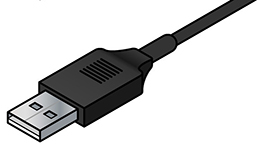
The classic USB plug that we are all familiar with, the Type-A USB is the larger standard rectangular plug. Whilst it’s gone through a number of changes to accommodate different versions of USB, the design of the plug remains the same, which means that all Type-A plugs and sockets are compatible no matter what version they are.
USB Type-B
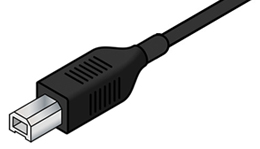
Usually the other end of a USB cable uses a Type-B connector. The Type-B plug is the tall plug with the slanted top corners. Variations on Type-B have been widely adopted due to the sheer necessity of having smaller plugs at the client device end.
The mini USB and micro USB are also variations of Type-B.
USB Micro-A
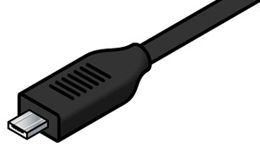
USB Micro-B
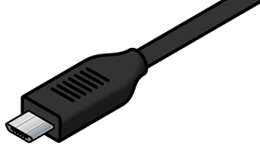
USB-C
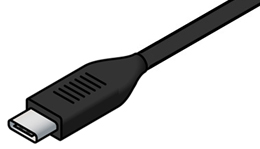
The headline feature of the USB-C is that it's reversible. It’s designed to be small enough to not need any mini or micro variants. The intention is that it will completely replace all types of USB on both host and client devices.
USB charger versions
The various upgrades focus on improvements in terms of speed and features. Since its official release in 1996, there have been five versions of the USB:
- USB 1.0
- USB 2.0
- USB 3.0
- USB 3.1
- USC-C 1.0
Whilst the USB 3.0 is currently the most common, it is predicted that the new USB-C connector could eventually replace this. The USB-C (or the USB Type C) was made widely available from 2015, and is now common on new model smartphones as well as some laptops. The intention is that it will completely replace all types of USB as the USB-C is a replacement for both ends of the cable. USB-C 1.0 brings in the new power standards and speed advantages similar to that of USB 3.1.
How USB-C charging works
The USB-C is entirely different from its predecessors. The connector is universal and therefore it will work when used either way. It also outputs more power, as well as the theoretical output. There are also plenty of USB chargers that don’t fit into this specification, such as AC adapters.
Frequently asked questions about USB chargers
To help you understand how to use your USB chargers, we’ve answered some key questions on the safety of USB charging.
1. Could my USB device be dangerous?
Certified USB devices are in general very safe to use, as long as they are used correctly in accordance with the manufacturer’s instructions.
2. What is the difference between a smartphone USB charger and a tablet USB charger?
It’s important to check the rating of the chargers, to ensure that the output is correct for your device. Do not simply assume that if they have the same physical connection the output will be the same. A supply of an incorrect charge may result in damage to your device and the potential risk of overheating and fire.
3. What happens if I mix and match a USB charger cable with a USB plug?
There is the potential for an incorrect charge to be applied to your device. This could result in a number of issues, including battery and device damage and the risk of overheating, fire and explosion. You should always follow the manufacturer’s instructions.
4. Is it safe to plug any USB device into a laptop, tablet or wall socket?
In most cases this should be acceptable. Plugging USB devices into “smart” products such as laptops and tablets which monitor and control the output should, in theory, be safer than the use of wall sockets. However, as always, check the manufacturer’s instructions.
5. Is it safer to charge my e-cigarette with a laptop or a USB wall plug?
The number of people using electronic cigarettes has increased dramatically in recent years. With many different types available it’s important to follow the manufacturer’s instructions.
If you want to avoid the dangers of e-cigarettes, then just follow our simple tips.
6. When should I charge my device with my USB charger?
Electrical Safety First advises that you don’t leave things charging when you leave the house or are asleep. If you absolutely have to, then make sure you have a working smoke alarm.
7. What are the dangers of charging my USB device in my car?
Check that the device is suitable for car charging. The dangers are similar to normal USB hazards, but with the added risk element of using them whilst on the road.
Types of USB port
There are three types of USB port dictated by the actual current specs (milliamps or mA).
Dedicated charging port
A dedicated charging port applies to power sources like wall chargers that do not enumerate, so charging occurs with no digital communication at all.
Downstream port
A charging downstream port can be found on a computer or laptop and can supply up to 1.5A, whilst allowing a USB to be detected and begin charging before enumeration (which is when the digital communication takes place).
Standard downstream port
A standard downstream port can be found on a computer or laptop and needs to enumerate (start digital communication) to be USB compliant, however most present-day hardware does draw power without enumerating.
Voltage and Amperage
Not all USB connectors, cables and chargers are equal. For example, some wall chargers can supply more power than others and one particular USB socket on a laptop may vary in power from the others, or PCs with some able to charge whilst in sleep mode.
You will also need to consider Amperage. Chargers increase the current to provide a higher amount of power quickly – this is measured in amps and the more amps means the more power. Therefore, a charger that comes with a smartphone will provide less amps than a charger that come with a tablet. You will need to consider voltage and the equipment you’ll need to use to enable the use of USB chargers when travelling internationally.
Safety Concerns
Uncertified chargers come with serious safety concerns. Similar to unofficial batteries, uncertified chargers can be bought at a reduced price online, from overseas or in high street shops and these kind of electrical products may present a higher risk of exploding or catching fire. Not only do they present a risk to you, the use of uncertified chargers may also damage your phone (which in turn could void your guarantee).
Cheap devices often fail to meet the requirements of the Electrical Equipment (Safety) Regulations 2016. The money that you save comes with extremely high risks and therefore buying a branded/certified charger is essential to avoid often fatal repercussions.
